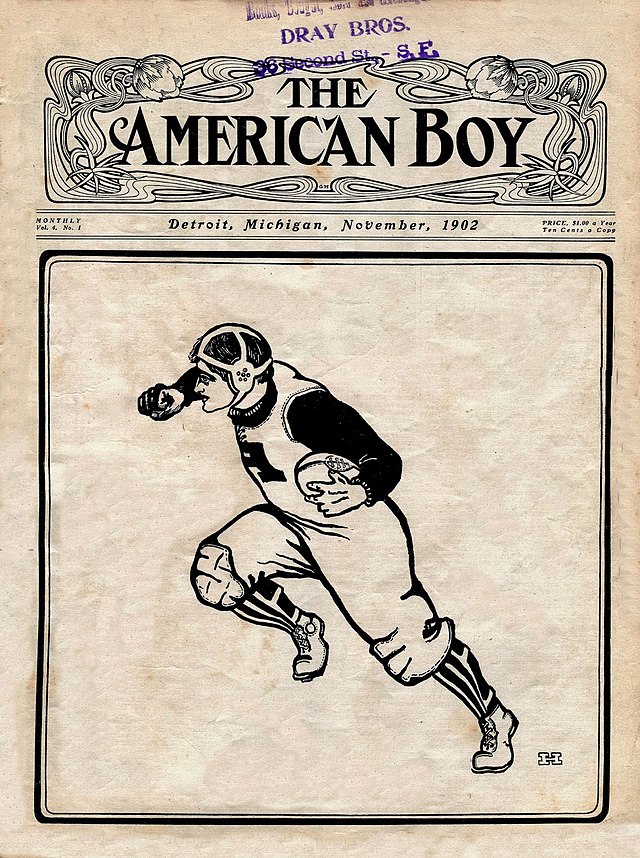We have learned that professional football first organized and NFL started as the American Professional Football Association after a September meeting at a car dealer in Canton, Ohio. We also know that the NFL didn't have a title game until 1933. What if there was a National Football League and a championship tournament played in 1902? Well kind of...
The Original National Football League
An Earlier National Football League

The American Boy Magazine Cover in November 1902 shows the popularity of football in that era, Courtesy Wikimedia Commons by an unknown artist.
According to the Pro Football Hall of Fame's website there was an NFL, decades before 1922 when the American Professional Football Association changed its name to the National Football League. According to the time line of ProFootballHOF.com in 1902:
Baseball's Philadelphia Athletics, managed by Connie Mack, and the Philadelphia Phillies joined the Pittsburgh Stars along with another New York state team, Watertown Red Blacks to form a professional football group , that they named the National Football League. Yes that is right there was an NFL long before Thorpe, Halas, Hay, Carr and the rest of them met in Canton in 1920. The Pro Football Researchers Association has a pretty awesome article in a 1980 edition of the organization's Coffin Corner Magazine, titled the First Football World Series. The article fills us in that;
"The first three (the Pennsylvania squads) had formed what they called the "National Football League," beat everyone else into the ground, and tangled their "league" standings so monstrously that no one is certain to this day who won. The fourth football power, Watertown, humbly claimed to be "champions of the world" already..."
.jpg)
The Philadelphia Athletics Football team of 1902, Courtesy Wikimedia Commons by an unknown photographer.
The author explains that it is a head scratcher on the Watertown claim as they got crushed at home when the Athletics visited the Red Blacks in October. The Pro Football Hall of Fame's website tells of a different top team altogether;
"All three teams claimed the pro championship for the year, but the league president, Dave Berry, named the Stars the champions. Pitcher Rube Waddell was with the Athletics, and pitcher Christy Mathewson a fullback for Pittsburgh."
A tournament to play
As the season wound down and the holidays were upon the country, and the manager of the Madison Square Garden in New York City, named Tom ORourke had an issue. He had a big beautiful building that would be devoid of any people on New Years Day 1903. There were plenty of social events in the Big Apple occurring but the Garden needed something to draw New Yorkers in as well to keep cash flow going in this expensive venue for events. O'Rourke probably stood in the giant indoor stadium and tried to envision something different for fans to watch. It donned on his finally that perhaps the exciting game of football could come indoors, and maybe this pro circuit that had four teams claiming the title could find resolution in a tournament format in NYC.
Tom strategically plotted the idea out. He would definitely invite the Philly teams and Watertown, but would anyone in the Big City pay a penny to want to see a Pittsburgh team play. Probably not, so the Stars were scratched from the invite list. Watertown declined the invite as they worried it may taint their claim to the 1902 title. The Athletics and Phillies didn't accept as intact clubs either, rather combining into a partial semblance of a team to play in the O'Rourke tourney. The 1980 PFRA Coffin Corner post explains the roster blend;
"The squad, made up of eight Phillies and four Athletics, boasted Charley Gelbert, three times All-American end, and Blondy Wallace, twice named to the second AA team at tackle. The center, W.E. Bachman, had also received a few AA plaudits at Lafayette, and several other players had names recognizable in New York back then. These included fullback Curly Davidson and Benjamin Franklin Roller, a great player at several positions."
This was a Philly All-Star mash up team, easily the hands-on favorites to win the tourney. O'Rourke and the Philadelphia contingent then did a genius act of marketing promotion. They re-branded this squad the New York team so as to give his hometown audience a solid odds-on favorite to cheer for. However these turned down invitations and morphed teams were not part of the organizer's plan, but he would roll with the punches. Tom filled the rest of the card with the best teams that he could bring in.
The New York Knickerbockers Field Club was a local Big Apple team, along with the Orange, New Jersey Athletic Club. Neither one of these clubs were powerhouses to the caliber of the Athletics/Phillies mixed roster at least on paper, but they were by no means fodder for the slaughter either. Another entry the Syracuse Athletic Club promised a comeptitive team and the entrants were rounded out with the Warlow Athletic Club that promised some good talent on tits roster along with a well represented cheering section. So the field was complete with five teams for the indoor exhibition.
Tournament Rules
Placing the game of football indoors in restricted dimensions proved to be a hurdle that O'Rourke and company had to overcome. The playing surface was reduced to 70 yards long and 35 yards wide. We have to remember that back in 1902 the field from goal line was 110 yards and the width of the Square Garden turf was reduced by about 40% too.
Then there was a matter of the playing surface. A New York Times article describes the planner's solution as this;
"The wooden flooring of the big garden was taken up, and the gridiron was laid out on the earthen surface, which proved to be rather too sticky and holding for fast work."
The speed and agility of some players were nullified by this sloppy treacherous track, so the speed kills montif would be all but absent in the tourney.
Perhaps the biggest blow to the strategies of the game of 1902 was the kicking restrictions. This is four years before the legal forward pass was introduced into the game of football. Punting the ball was an extremely important element and strategy of the game then. Author Timothy Brown in his splendid book, How Football Became Football; 150 Years of the Game's Evolution, fills us in that in this 1902 season punts were different than we know them today. Prior to some 1903 rules tweaks the player that punted the ball could make his own teammates eligible to recover and possess a loose punted ball by racing past them. Every teammate that the punter could advance beyond down the field would become a viable recovery candidate much like the onside free kicks we know today. With the ceiling height of the Madison arena at issue the punt arcs were greatly restricted thus the distance of the kicks were effected too.
The schedulers of the tourney used some wise tactics to make it intriguing for patrons to attend the events. FIrst up was the New York "Philadelphians" against Syracuse Athletic Club. The logic was that the fans could get an emotional connection to their so called "hometown" team as they were thought to be able easily dispatch the threat from central New York State. Day two would pit the Warlow A.C. team against the Knickerbockers. The winners of second night would surely have to face the locals from Philly and supposedly be badly beaten so that this powerhouse "New York" roster could claim to be the best in the State and then in evenong number three of entertainment battle against the one and only reprentatives from New Jersey in the Orange Athletic Club for the title of World Series Champ. However as in many cases the best laid plans sometimes have a hitch in them.
The 1902 World Series of Football Competiton
The fly in the ointment was Syracuse as they groomed their roster accordingly, as they took their desire to win it all, very seriously. The Syracuse Athletic Club commissioned Frank "Buck" O'Neill to beef up the roster of the Club to become the ultimate competitors of the format. O'Neill would later go on to be a very succesful coach at Syracuse University but he showed to gridiron organization skills well here early on too. Buck O'Neill built the team from the outside in, with himself on one end and a tough player named Carver on the other they then searched for strength up the middle. Jack Wright of Columbia proved to be the strong center they needed and then the other pieces fell into place. Carlisle Indian School standout brothers Hawley Pierce and Bemis Pierce magnificently filled the line on one side of Wright and another set of bros in Glenn "Pop" Warner (yeah that guy) and his sibling Bill Warner, the All-American at Cornell would shore up the the other side in the trenches. The more than capable regular quarterback of the Syracuse A.C. named Moore held his position while recruits from Watertown's team in Phil Draper, Mason and Bottger represented the Red Blacks on the Syracuse squad. The Philly boys would undoubtedly have their hands full and not have the cake-walk that was expected. This All-Syracuse team practiced daily inside at the Syracuse Armory and thus were prepared for the indoor style of play. It was a hard fought battle in night one with the only scoring being Bottger's plunge over the goal line to lead Syracuse to an unexpected 6-0 victory. Pop Warner though suffered a laceration to the head early in the first game that though afforded him to complete game one proved to be serious enough to prevent him from playing further in the tourney.
Night two saw another competitive game as the Knickerbockers bested the Warlow squad 11-6. The showdown in evening three of the World Series of Football had an interesting replacement for the now injured Glenn Warner, as Blondy Wallace of the now dispatched New York Philadelphians filled the bill on the Syracuse line. According to a New York Tribune report on January 1, 1903, the Knickerbockers feeling a bit slighted in this replacement scenario threatened to sit out New Years Eve's game unless they were promised a minimum $250 purse for playing up from the original $100 guarantee. Their stall tactic worked as the team leaders were handed the demand in cash before the game. Syaracuse's All-Stars put a whopping on the now paid Knicks 36-0 to set themselves up for the tourney title game on Friday January 2. This game was so one-sided that reports are that the second hald was reduced to a mere ten minutes long.

O'Rourke put some fanfare flavor into the final game of the World Series of Football 1902. Fans were able to witness a Gaelic football exhibition primer match prior to the Syracuse versus Orange showdown. The Kickhams of New York against Brooklyn's Emmets in the 15 on 15 Gaelic contest probably churned up the already loose sod of the makeshift areana surface. In the tournament finale the well rested Orange A.C. was not match for their Syracuse opponents. They didn't fair any better that the Knickerbockers the night before, also falling 36-0 although they did endure the entire 40 minurs of the game.

So it was quite different than we know in pro football today but in 1902, there was a National Football League, A World Series played in football played about 10 months earlier than Major League Baseball palyeded their first championship series of the same name when the Pittsburgh Pirates fell to the Boston Americans in early October 1903.
Banner Photo Credits
The pic in our banner for this article is courtest Wikimedia Commons in a photograph taken by Hemment for Spalding' How to Play Foot Ball, featuring work by Walter Camp in 1902, and the New York, American sports publishing company.






